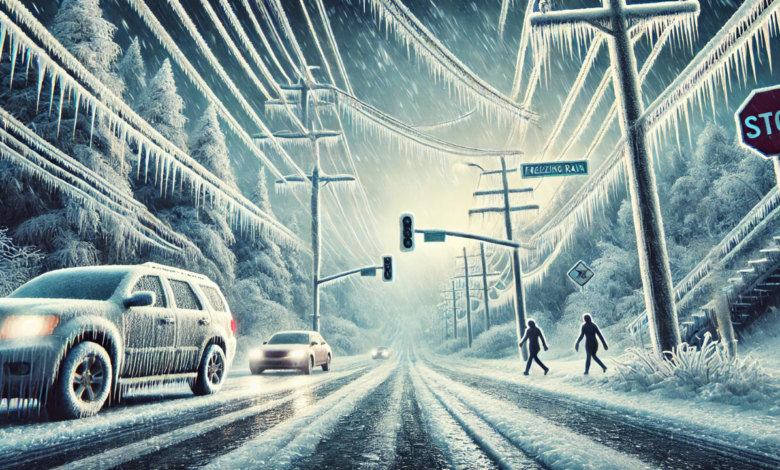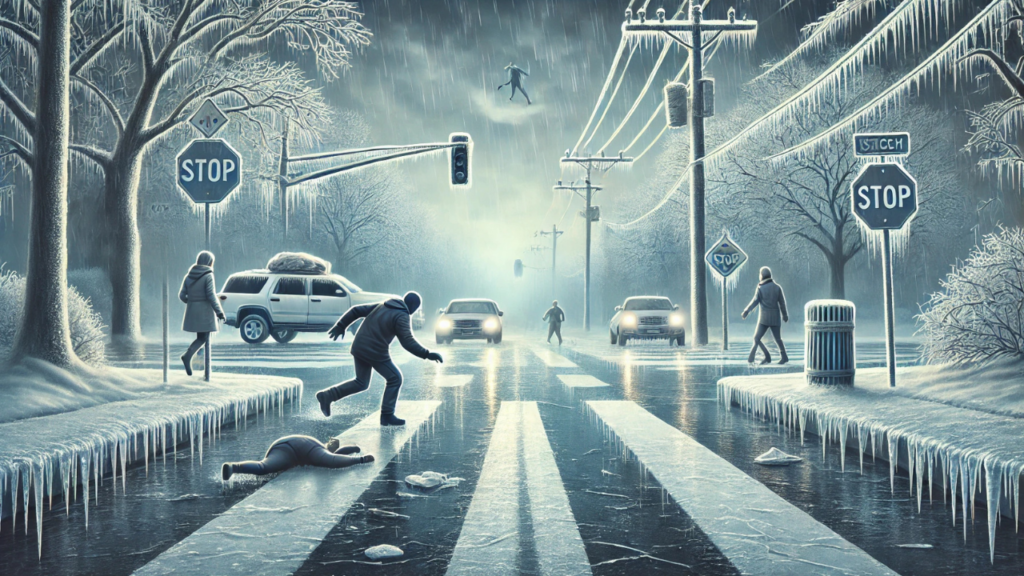Freezing Rain: The Hidden Dangers and How to Stay Safe

Introduction
Freezing rain is precipitation that occurs when rain falls through a layer of cold air near the Earth’s surface, causing it to freeze upon contact with surfaces such as roads, trees, and power lines. Unlike regular rain, which can be easily absorbed into the ground or evaporate, freezing rain creates a hazardous layer of ice that can disrupt daily life. While it might seem rare, freezing rain can significantly impact safety and infrastructure, making it crucial for individuals to understand its dangers and how to stay safe.
In this article, we will explore the science behind freezing rain, its effects on daily life, how to stay safe during freezing rain events, and how meteorologists predict this phenomenon. By the end of this guide, you’ll be better prepared to face freezing rain and avoid potential hazards.
What is Freezing Rain?
Freezing rain occurs when liquid water droplets fall from the sky but encounter a layer of cold air just above the ground. Rain instantly turns into ice when it hits surfaces at or below-freezing temperatures. This is different from snow or sleet, as those forms of precipitation freeze while still in the air. In the case of freezing rain, the droplets remain liquid until they make contact with the surface, where they solidify.
The formation of freezing rain is a complex process that depends on the specific layering of temperature and moisture within the atmosphere. Typically, there’s a warm layer of air aloft, followed by a colder layer closer to the ground. When the rain falls through the warmer air, it stays liquid until it hits the frozen surface, creating dangerous ice accumulations.
While it may appear similar to sleet or hail, freezing rain is more dangerous because it forms a smooth, icy layer that can accumulate on roads, sidewalks, and power lines, making it especially treacherous. Unlike sleet, which is more granular, or hail, which forms large chunks of ice, freezing rain creates a thin, invisible layer of ice that is difficult to detect but can cause significant damage.
- The Impact of Freezing Rain on Daily Life
Freezing rain can disrupt daily life in numerous ways, mainly its effects on transportation, infrastructure, and personal safety. One of the most immediate concerns is the hazardous driving conditions it creates. As the rain turns to ice, roads become slick and dangerous, making it difficult for drivers to maintain control of their vehicles. Even a small amount of ice on the streets can result in severe accidents, especially if drivers are unprepared or unaware of the conditions.
Power outages are another significant impact of freezing rain. The weight of the accumulating ice can cause tree branches to break, which may fall onto power lines and result in widespread electrical disruptions. These power outages can last for hours or even days, depending on the storm’s severity and the damage to infrastructure. The danger is not limited to power lines; freezing rain can damage buildings, vehicles, and other structures, requiring costly repairs.
Pedestrians are not immune to the risks either. Walking on icy surfaces can lead to slips and falls, which may result in serious injuries. As the ground becomes covered in ice, people must be extra cautious when walking outside, particularly when navigating areas like driveways, parking lots, and sidewalks that might not be immediately treated with salt or other de-icing agents.
In addition to these personal risks, the wider community also feels the effects of freezing rain. Airports may face flight delays or cancellations due to ice accumulation on runways, and public transportation systems may struggle to operate as buses and trains become impaired by icy conditions. Freezing rain events can also impact emergency response times, as first responders face additional obstacles while assisting those in need.
How to Stay Safe During Freezing Rain
Staying safe during freezing rain requires both preparation and caution. The first step is to prepare your home and car for the storm. Before freezing rain strikes, make sure that your home is properly winterized. This includes ensuring that windows and doors are sealed to prevent drafts, adding extra insulation where needed, and keeping a stock of de-icing materials like salt and sand. These materials allow you to treat walkways and driveways promptly, reducing the risk of slips and falls.
Proper winter tires provide better traction on icy surfaces. Keep your windshield wipers in top condition and ensure your car’s antifreeze levels are sufficient to prevent freezing. An emergency kit, including blankets, extra food and water, and a flashlight, is also essential if you get stranded during a freezing rain event.
Regarding driving, the best advice is to avoid traveling unless necessary. If you must drive, reduce your speed, increase your following distance, and drive cautiously. Avoid sudden stops or sharp turns, as these can cause your car to lose traction. It’s also wise to keep your headlights on and use your defroster to ensure maximum visibility.
If you’re walking outside during freezing rain, wear sturdy, non-slip footwear and stroll, keeping your weight centered. Be mindful of areas that may be remarkably slippery, such as intersections or spots under trees where ice can accumulate from falling branches. If possible, stay indoors until conditions improve.
Staying informed is also critical. Monitor weather forecasts to stay ahead of changing conditions and sign up for weather alerts or notifications from local authorities. Many apps and websites provide real-time updates on weather events, and knowing when freezing rain is expected can help you plan your day accordingly.
The Science of Freezing Rain: Meteorology and Forecasting

Understanding the science behind freezing rain can help us better prepare for its occurrence. Meteorologists rely on advanced forecasting tools to predict when and where freezing rain will likely occur. Radar, satellite data, and weather stations track the temperature, moisture levels, and wind patterns in the atmosphere. These factors determine whether freezing rain, snow, or sleet will fall in a given area.
Freezing rain typically forms when warm, moist air rises over a layer of cold air near the surface. This warm air causes the precipitation to remain liquid as it falls, but when it reaches the ground, it freezes upon contact. This process requires a delicate balance of temperatures, with just a tiny variation leading to different types of precipitation. If the layer of cold air near the ground is too thick, snow will form instead of freezing rain, and if it’s too warm, rain will fall as liquid.
Forecasting freezing rain can be tricky, depending on precise temperature readings at various altitudes. Meteorologists use weather balloons and other instruments to measure these conditions, allowing them to predict where freezing rain will be most likely. While technological advances have made weather predictions more accurate, the dynamic nature of the atmosphere means that forecasts are not always perfect. Residents need to stay informed and be ready for unexpected changes in the weather.
Conclusion
Freezing rain is a dangerous and unpredictable weather phenomenon that can majorly impact daily life, from hazardous driving conditions to power outages and personal injuries. Understanding how freezing rain forms, its effects, and how to stay safe during these events is essential for reducing risks and maintaining safety. By being prepared, staying informed, and exercising caution, we can minimize the dangers of freezing rain and ensure that we are ready for whatever the weather brings.
Frequently Asked Questions (FAQs)
What’s the difference between freezing rain and sleet? Freezing rain forms when liquid rain hits the ground and freezes instantly, creating a layer of ice. Sleet, on the other hand, occurs when frozen raindrops fall from the sky before reaching the ground.
Can freezing rain be predicted in advance? Meteorologists use radar, satellite data, and weather stations to expect freezing rain. However, precisely forecasting is still challenging, and conditions can change unexpectedly.
How can I protect my car from freezing rain damage? Ensure your vehicle is equipped with winter tires, maintain your windshield wipers, and keep your vehicle’s antifreeze levels topped off. Keep an emergency kit in your car in case you get stranded.
Is it safe to drive in freezing rain? Driving in freezing rain can be highly hazardous. If possible, avoid driving. If you must drive, reduce your speed and increase your following distance.
What are the first steps to take if a freezing rain warning is issued? Monitor weather alerts, prepare your home and car for the storm, stay indoors, and avoid traveling unless necessary.
How long can freezing rain last, and how quickly can conditions worsen? Freezing rain can last a few hours to over a day, and conditions can deteriorate rapidly as the ice builds up on surfaces.
What are the best ways to prevent slips and falls during freezing rain? Wear non-slip footwear, stroll, and avoid areas particularly icy or under trees where ice may accumulate.
How does freezing rain impact wildlife and plants? Rain can damage trees, bushes, and other plant life by coating them in heavy ice, causing limbs to break or entire plants to freeze. It can also make food sources scarce for wildlife.
Can freezing rain cause long-term damage to infrastructure? The accumulation of ice can significantly damage power lines, roads, and buildings, leading to long-term outages or repair needs.
What are the key differences between freezing rain and regular rain? Freezing rain freezes upon contact with surfaces, creating ice, while regular rain does not freeze and typically evaporates or is absorbed into the ground.
You May Also Read:https://bestusatime.com/houzz-pro/



